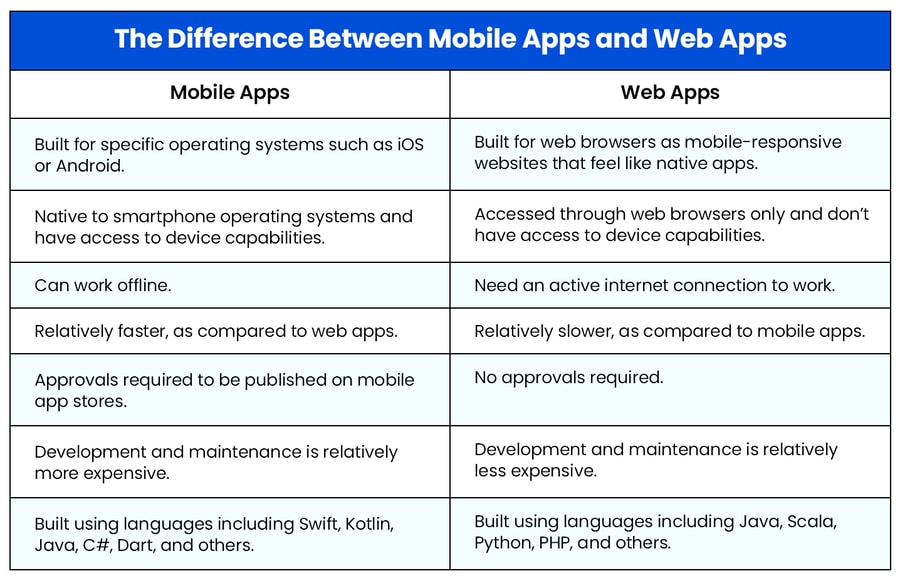A web app is a program stored on a remote server and accessed through an internet browser, such as Google Chrome or Safari, on a device of the user's choosing.
Users don't need to install a web app onto their smartphone, tablet, or desktop to be able to use it. They also don't need to maintain it, as web apps receive automatic updates, ensuring they're always up to date and making them less prone to security breaches.
Web apps enable users to interact with content and perform specific tasks, such as posting on social media, streaming a film, or transferring money. Commonly used web applications include Gmail, PayPal, Venmo, Google Drive, Facebook, Netflix, Etsy, and Amazon.
Many of these commonly used web apps can also be downloaded as mobile apps from iOS or Android app stores. However, it's essential to know that web apps differ from both mobile apps and websites. Here are the differences:
- Web apps vs mobile apps. Web apps look and function a lot like mobile apps. However, mobile apps are downloaded via an app store and run on the device itself, whilst users will access a web app via their internet browser. In addition, mobile apps have access to device resources, such as the camera, while web apps cannot always access device features.
- Web apps vs websites. They are both accessed through web browsers and require an internet connection. However, websites are static, interconnected web pages that are primarily for information dissemination, whilst web apps are designed for user interaction and functionality.

(Image Source: Successive Digital)
Despite their differences, web apps, mobile apps, and websites are all equally capable of making money through various methods and strategies. Developers and business owners can implement any number of web app monetization strategies to generate revenue and make profits, but this isn't always an easy task, as you have to keep the user experience in mind.
This article will explore how to monetize a web app in five creative ways.
4 Creative Ways To Monetize Your Web App
1. Advertising
Advertising is currently the most popular web app monetization strategy. To implement this strategy, business owners need to find several partners who can add to the digital customer experience and want to pay to promote their products or services within the web app.
However, a great monetization strategy is also about keeping users happy, so ad placement and relevance are important things to consider. Your ads must be limited and customer-centric so that users don't leave your web app.
There are a range of advert options available, including:
- Video ads. These short (usually no more than 30 seconds) videos can be displayed within the app as skippable or non-skippable.
- Banner ads. These banners can be displayed in the bottom, top, or corner of the screen to draw attention to your partner's products or services.
- Display ads. These full-page adverts, which can be either animated or static, will stay on the screen until the user dismisses them.
- Interstitial ads. These are similar to full-screen display ads, but they appear between user interactions or when a page is loading.
- Reward ads. These ads are displayed to users who can choose to watch them in return for a reward within your web app. This type of advert is often seen in gaming apps when users watch short videos for extra points, coins, or lives.
- Native ads. These ads blend into your app's content, making them contextually relevant and non-invasive for users.
It's essential to remember that advertising is not a great monetization strategy for all web apps, such as online banking systems, but it works well for games and fitness apps.
2. In-app Purchases
In-app purchases (IAPs) are a monetization strategy that enables users to buy additional features, extra content, or virtual goods within the web app. There are two types of IPAs:
- Consumable IAP. These purchases provide a one-time benefit to the user and can be used immediately.
- Non-consumable IAP. These purchases provide a recurring benefit to the user for as long as they continue to use the web app.
This strategy works well for gaming apps, productivity tools, and fitness web apps. For example, if you are creating IAPs for a fitness app, you can allow users to purchase additional at-home workout routines that aren't available for free.
3. Affiliate Marketing
Affiliate marketing is a fantastic monetization strategy that allows businesses to earn money by referring your web app users to third-party products or services. Like the IAP strategy, you must build partnerships and collaborate with third-party businesses or experts.
When a user interacts with the affiliate link on your web app in the desired way, you receive a percentage of the sale from that affiliate. Depending on what the third party wants, there are three ways you can generate revenue from an affiliate link:
- Pay-per-click (PPC). Each time your web app user clicks on the affiliate link, you will earn revenue for your business from the third-party business.
- Pay-per-sale (PPS). You will only earn revenue if your web app user completes a third-party purchase using the affiliate link.
- Pay-per-link (PPL). You will only earn revenue if your affiliate link generates a lead for the third-party business.
This monetization strategy is low-risk and low-effort, as you earn a commission without dealing with inventory, and your affiliate links will continue to earn money after the initial setup.

(Image Source: All Around)
However, you must know your audience and what interests them so that you can promote products or services that resonate with the wants and needs of their user base. For example, a flight booking web app earns commissions by directing users to specific hotels.
4. Free Trials
Removing any barriers between your web app and a potential customer will help grow your audience and retain their attention.
For apps that have a paid version as well as a free one, offering free trials for new users will allow them to try out the full version of your app without having to pay. This way, they can experience all of the features for themselves and see firsthand the value that your app can bring.
This strategy increases the likelihood of users wanting to continue using the paid version of their app once their free trial ends, encouraging them to sign up.
There are two ways that free trials can be implemented:
- No card details. The user would have instant access to the free trial without having to provide payment details. This tends to result in more signups, but often these users may not be serious about continuing after the free trial ends.
- Card details required. This means users must enter their card details to access the free trial. Often this would take a payment once the free trial ends to keep the subscription going. Although this can increase conversions, it can be a deterrent for casual new users who are looking around at different options.
Ready To Make Money Via Your Web App?
Each monetization strategy has a range of advantages and disadvantages for different business types. For example, IAPs can enhance the user experience, while advertising can hinder it.
However, most web apps rely on a combination of the above monetization strategies to maximize revenue and profits. Finding the right mix for your web app is key, and the best time to plan your monetization strategy is before development begins.
Once you've implemented a monetization strategy, tracking its performance is essential to learn what's working and what's not, how your web app users behave, and how your revenue is increasing. The key performance indicators (KPIs) you should pay attention to are churn rate, customer lifetime value (CLTV), conversion rate, average revenue per user (ARPU), and return on investment (ROI).
About the author
Ricardo Meneses Flores is a data journalist at Hostinger, specialising in visualization and geospatial analysis. Hostinger empowers businesses with fast web hosting, an AI-powered Website Builder, and an intuitive control panel. With 24/7 support and cutting-edge technology, it ensures seamless website management for users of all skill levels.









These cookies are set by a range of social media services that we have added to the site to enable you to share our content with your friends and networks. They are capable of tracking your browser across other sites and building up a profile of your interests. This may impact the content and messages you see on other websites you visit.
If you do not allow these cookies you may not be able to use or see these sharing tools.